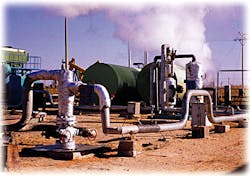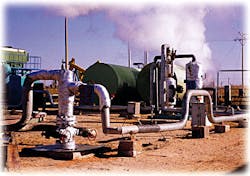Guntis Moritis
Production Editor
A SAGD test is under way in a Liaohe heavy oil field in China. Shown above is the wellhead of one of the two horizontal wells in the SAGD pilot. (Photo by Guntis Moritis)A pilot test in the Liaohe heavy-oil area in China will determine if steam-assisted gravity drainage (SAGD) is applicable for the recovery of the sizable heavy-oil reserves found in the region.
The paired horizontal wells are in the extra heavy oil Xinglongtai reservoir, in Block Du84 of the Shu No. 1 area.
In the SAGD process, steam is injected into the reservoir through one horizontal lateral lying above a horizontal producer near the bottom of the reservoir. Heated oil and condensed steam are produced through the horizontal producing lateral.
Liaohe oil fields
The Liaohe oil fields ( Fig. 1 [31,485 bytes]) lie in Northeast China, south of Shenyang, the capital of Liaoning Province. Liaohe Petroleum Exploitation Bureau (LPEB), a unit of China National Petroleum Corp. (CNPC), operates the fields that encompass an area of 12,400 sq km (3 million acres) onshore and 3,500 sq km (860,000 acres) offshore. The offshore portion in Liaodong Bay, a northern extension of Bohai Sea, has not been developed.The city of Panjin is a major center of oil field activity. The Liao River flows through the area. (In Chinese "he" means river.)
The Liaohe area is a flat terrain, crisscrossed by rivers and having a temperate climate where rice is cultivated.
Field history
Exploration in the Liaohe area started in the 1950s. A geological survey was carried out in 1955 and the first exploration well was drilled in 1964. In 1966, the first commercial oil and gas flow was obtained from Well Liao 6, after which began full-scale exploration and development.
In 1971, the Xinglongtai oil field was put into production followed by the Shuguang, Huanxiling, and Shuangtaizi oil fields.
LPEB describes the Liaohe oil fields as being in a Mesozoic rift-subsidence basin. Frequent fracturing at an early stage produced well-developed faulting. The area is complex with many oil and gas fields containing a multiple series of formations, various oil/water contacts, and many different reserve types containing both oil and gas.
In more than 30 years of exploration, 33 fields have been discovered. These fields contain both light and heavy oil as well as gas (Fig. 2 [13,434 bytes]).
Of these fields, 29 are being produced. The main fields include Xinglongtai, Shuguang, Huanxiling, Gaosheng, and Shenyang. Hydrocarbons are produced from 17 formations, with the main ones being Niuxintuo, Gaosheng, Dujiatai, and Lianhua.
In 1997, oil production was about 300,000 b/d (15 million tons/year) from the area (Fig. 3 [16,399 bytes]), making it the third largest producing area in China, behind Daqing and Shengli.
Heavy oil development
LPEB describes the Liaohe area as having 11 formations containing proved heavy oil in place of about 887 million tons (5.8 billion bbl). It indicates that the reservoirs are of diverse reservoir types, deeply buried for heavy oil, and containing a variety of crudes.LPEB characterizes the reservoirs as alluvial fan facies, fan-delta facies, and sublacustrian fan facies. The fan-delta facies is the predominant one.
The heavy oil reservoirs are at depths between 1,700 and 2,300 m.
LPEB classifies the reservoirs into two categories: massive oil pools and interbedded reservoirs, which predominate.
The reservoirs have high porosity and permeability. Porosity ranges from 23 to 30% and can be as high as 35%, while the permeability ranges from 0.5 to 3.0 Darcies and can reach 5.3 Darcies.
The reservoirs are further classified by LPEB as oil edge-water drive, bottom-water drive, and gas-cap edge-water drive reservoirs. The predominant type is edge-water and bottom-water drive reservoirs.
The crude is characterized as normal heavy oil, 50-10,000 cp viscosity, special heavy oil, 10,000-50,000 cp viscosity, and extra heavy, 50,000 cp viscosities and higher. Heavy oil is the most common.
LPEB indicates that the highest viscosity of degassed heavy oil can be more than 100,000 cp.
Since the beginning of thermal recovery in the early 1980s, the production of heavy oil has expanded rapidly with annual average increment increases of 600,000 tons (10,000 b/d). By 1997, the annual heavy oil production reached 8.5 million tons/year (147,000 b/d) or about 56.5% of LPEB production.
LPEB has also started producing extra-heavy oil, viscosity greater than 100,000 cp, on a commercial scale with conventional steam-stimulation techniques.
Production techniques
To produce heavy oil, LPEB uses a variety of technologies that include:
- Conventional water flooding
- Steam injection
- Well bore heat insulation
- High-temperature sand control
- High-temperature viscosity reduction
- High-temperature demulsification
- High-temperature temporary block-off techniques
- High-temperature profile control
- Well bore cleanup techniques
- Polymer fracture control
- Blockage-removal techniques
- Steam flooding
- Side-tracked well steam stimulation.
SAGD test
In February 1997, the steam-assisted gravity drainage wells were drilled ( Fig. 4 [34,530 bytes]) in the Du-84 block of the Shu-1 area. The SAGD field test was started in May 1997.The test well group is made up of a pair of horizontal wells (Shuping 1-1 and Shuping 1-2) and four observation wells.
LPEB based the design of the test on the experiences gained in other countries and the characteristics of the reservoir in the Shu No. 1 area. LPEB said it conducted thorough studies in regard to drilling and completions, injection and production, dynamic monitoring, and surface automatic control. Computer Modeling Group Ltd., Calgary, assisted in the reservoir simulation.1
The horizontal sections of the two horizontal wells are 300 m long. The maximum vertical distance between the two wells is 11.98 m, and the minimum is 10.43 m with the lateral error of 2.74-0.51 m. These distances are very close to the 10 m planned for these wells. The lower horizontal lateral is about 8 m from the bottom of the reservoir.
The reservoir contains 10° API gravity oil with a viscosity of more than 120,000 cp at reservoir conditions. Porosity ranges from 25 to 31%, with horizontal permeability ranging from 1-2.6 Darcies. The oil saturation is 60-69%.
The SAGD process has four injecting and producing stages. In the first stage, the reservoir is preheated by steam circulated through the horizontal producer and the injector at the same time. After the surrounding reservoir in both wells has been heated and heat communication has been established, the injector is used for injecting steam into the reservoir, increasing its pressure and creating a steam chamber.
During the third stage, the pressure in the reservoir is reduced, and some of the heated oil and condensed steam is produced through the lower horizontal well.
The last stage is the SAGD production stage.
LPEB said that its project is now in the third stage, and it expects to be in the fourth stage by the end of 1998.
Reference
- Card, C.C., et al., "CNPC Liaohe Dual Well SAGD-The Journey from Vision to Reality," 7th Unitar International Conference on Heavy Crude and Tar Sands, Beijing, Oct. 27-30, 1998.
Copyright 1998 Oil & Gas Journal. All Rights Reserved.



